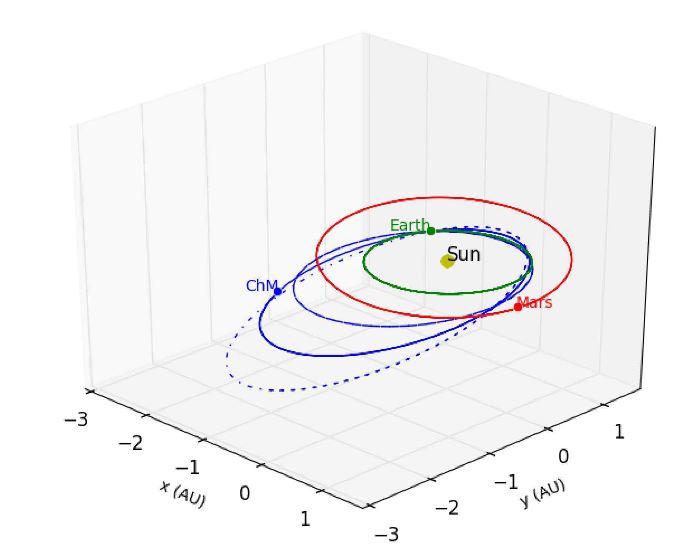- Joined
- Feb 11, 2008
- Messages
- 2,605
- Reaction score
- 17
- Points
- 53
This is from a Deltaglider at 1 lunar distance. (Rad is equal to the Moon's SMa)
You can see that less than 1/3 of the gravitational force is provided by Earth.
That the meteor and asteroid were both large and got so close was what was so notable about them. That they both occurred within the same 24 hour period make them extraordinarily unlikely.
These scientists both came to highly unlikely probabilities for this occurrence:
[FONT=Courier, Monospaced]A meteor and asteroid: 1 in 100 million odds.
By Meg Urry, Special to CNN
updated 8:16 PM EST, Mon February 18, 2013
http://www.cnn.com/2013/02/16/opinion/urry-meteor-asteroid/index.html
[/FONT]
Meteor over Russia causes shock waves that injure at least 950 Posted by: Dr. Jeff Masters, 3:12 PM GMT on February 15, 2013
http://www.wunderground.com/blog/JeffMasters/comment.html?entrynum=2350
...The 2029 close approach of the near Earth asteroid Apophis means this is a question that needs to be determined definitively. It also like 2012 DA14 is expected to come so close as to get inside the ring of geosynchronous satellites, but not impact. Apophis is so large though that, unlike 2012 DA14 , on closest approach it will even be visible to the naked eye. If it is the case that it can be accompanied by fragments that do impact then that is potentially very serious because its larger size means it would likely be accompanied by larger fragments.
To answer this question a statistical study needs to be made both of the Air Force infrasound detectors and the space radar detections to find whether on the 2012 DA14 close approach or on other previous close approaches whether there was an increase in meteor hits.
Hi all,
I still see suggestions popping up on this list about a possible link between
2012 DA14 and the Russian meteor.
I want to point out that even without an accurate trajectory for the Russian
bolide, a link with 2012 DA14 can be 100% rejected. The orbital geometry of 2012
DA14 and the latitude of 55 N for the Russian bolide make this impossible.
2012 DA14 and any fragments in a swarm in similar orbit, would approach the
earth from deep south. The geocentric radiant for the orbit of 2012 DA14 is at
declination -81 degrees. This means 2012 DA14 fragments approach earth almost
parallel to the earth polar axis, coming from the south. I.e. they approach
towards the south pole and the southern hemisphere.
This means fragments can impact on the southern hemisphere, but not on the
northern hemisphere (except very low latitudes north if we take earth
gravitational curvature of the final trajectory in account). Because the
northern hemisphere, and certainly a place as far north as 55 N, is at the "far
side" of the earth globe as seen from the 2012 DA14 entry direction.
Compare it with a car. A bird coming in frontal will always hit the front of the
car - it cannot hit the back of the car. Chelyabinsk at 55 North latitude is
"the back of the car" in this comparison, given the approach direction of 2012
DA 14 and any fragments of it.
- Marco
----
Dr Marco (asteroid 183294) Langbroek
asteroids at langbroek.org
http://www.marcolangbroek.nl
http://asteroids.marcolangbroek.nl
Once again, the two rocks were in DIFFERENT ORBITS. I'm not sure how else to explain it but different orbits means that there is no possibility that these two rocks were related. Different orbits mean that the arrival time was different - one in the morning and a flypast from the other direction in the evening. Different orbits. not related.
And Robert, aka RGCLARK, just check the You Tube video in post 200 in this thread.
Afterwards bent down, grab your ankles and kiss you're ass good bye.
Just joking.
There are so many rocks out there........





I pulled the following elements from this paper, but I am a little confused by the notation. Can anyone give me a lead?
q 0.82 periapsis? <----no units provided
OMEGA 326.70 I think this is the lon of ascending node
omega 120.62 I think this is the argument of periapsis
i 3.45 inclination
e 0.51 eccentricity
a 1.73 semi-major axis <----no units provided
I was hoping to put these into a scenario so we could ride the meteor in.
Why the double post, Thunder Chicken?
q 0.82 periapsis? <----no units provided
OMEGA 326.70 I think this is the lon of ascending node
omega 120.62 I think this is the argument of periapsis
i 3.45 inclination
e 0.51 eccentricity
a 1.73 semi-major axis <----no units provided
The description "the other direction" or as it's been called the "opposite direction" is misleading. It's more similar to an airline flight that goes from Minnesota to NYC compared to one that goes from Louisiana to NYC.
It's periapsis in AU (you can check that in the top-down view in graphics editor - I got about 100 pixels to green / 121 pixels to blue = 0.826 there).I tried the above with q = 0.82 representing mean anomaly, it isn't correct.
View attachment Meteoroid.scnBEGIN_DESC
Contains the latest simulation state.
END_DESC
BEGIN_ENVIRONMENT
System Sol
Date MJD 56337.9951500884
END_ENVIRONMENT
BEGIN_FOCUS
Ship GL-01
END_FOCUS
BEGIN_CAMERA
TARGET GL-01
MODE Extern
POS 7.90 52.33 -14.58
TRACKMODE GlobalFrame
FOV 40.00
END_CAMERA
BEGIN_MFD Left
TYPE Orbit
PROJ Ship
FRAME Equator
ALT
REF Earth
END_MFD
BEGIN_MFD Right
TYPE Orbit
PROJ Frame
FRAME Ecliptic
REF Sun
END_MFD
BEGIN_SHIPS
GL-01eltaGlider
STATUS Orbiting Earth
RPOS 113842059.18 24142157.20 -62559734.52
RVEL -8735.479 -1172.577 4622.038
AROT 92.14 -39.86 -7.70
AFCMODE 7
PRPLEVEL 0:1.000000 1:1.000000
NAVFREQ 482 540 84 114
XPDR 0
AAP 0:0 0:0 0:0
END
END_SHIPS
